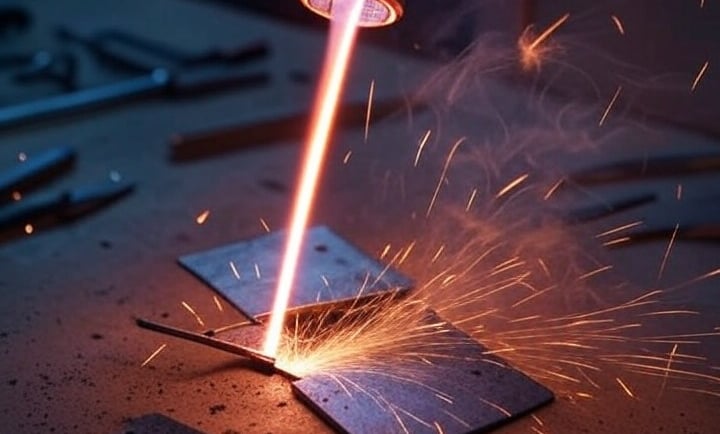Plasma Cutting Torch
Plasma Cutting Torch


A plasma cutting torch is a tool used in plasma cutting, a process that employs a high-velocity jet of ionized gas (plasma) to cut through electrically conductive materials like steel, stainless steel, aluminum, brass, and copper. The torch generates a plasma arc by forcing a gas (such as air, nitrogen, oxygen, or argon) through a narrow nozzle, where an electric current ionizes the gas, creating a plasma stream with temperatures up to 30,000°F (16,649°C) that melts and cuts the material.
Key Components of a Plasma Cutting Torch:
Electrode: Conducts electricity to create the arc, typically made of copper, tungsten, or other conductive materials.
Nozzle: Constricts and directs the plasma jet for precise cutting.
Swirl Ring: Creates a swirling motion in the gas to stabilize the plasma arc.
Shield/Deflector: Protects the nozzle and improves cut quality by shielding the arc from external interference.
O-rings and Retaining Caps: Secure the consumables and maintain proper alignment.
Types of Plasma Torches:
Handheld Torches: Used for manual cutting, ideal for smaller shops, automotive repair, or artistic metalwork. They can cut up to 1.5 inches (38 mm) of steel, depending on the model.
Mechanized/CNC Torches: Integrated into computer numerical control (CNC) systems for automated, high-precision cutting, used in industries like manufacturing and construction.
Non-Transferred DC Torches: The arc forms within the torch, used for applications like plasma spraying.
Transferred DC Torches: The arc forms between the torch and the workpiece, common for cutting due to higher efficiency.
Arc Starting Methods:
High-Frequency (HF) Start: Uses a high-voltage spark to initiate the arc, common in low-cost systems but may interfere with sensitive electronics.
Blowback Start: The electrode and nozzle are in contact, and gas flow initiates the arc, suitable for CNC systems.
Capacitive Discharge: Less common, uses a silicon-controlled rectifier for arc initiation.
Applications:
Metal Fabrication: Cutting intricate shapes in sheet metal or thick plates.
Automotive Repair: Cutting through rusted or damaged metal parts.
Construction and Manufacturing: Producing components for structures or machinery.
Metal Art and Signage: Creating detailed designs with precision.
Plasma Gouging: Removing weld imperfections or preparing surfaces.
Advantages:
Cuts a wide range of conductive metals quickly and precisely.
Produces clean cuts with minimal heat-affected zones compared to oxy-fuel torches.
Faster than oxy-fuel for thin to medium materials (up to 1 inch or 25 mm).
Safer, as it doesn’t use flammable fuel gases.
Disadvantages:
Requires a stable power source and compressed gas (e.g., shop air or gas cylinders).
Consumables (electrode, nozzle) wear out and need regular replacement, especially when cutting dirty or coated metals.
Limited to conductive materials; ineffective on non-conductive surfaces.
Safety Tips:
Wear protective gear (welding helmet, gloves, safety glasses).
Ensure proper ventilation to avoid inhaling fumes.
Attach the ground clamp securely to the workpiece, not the part being cut off, to avoid becoming the path for the electrical current.
Follow manufacturer settings for amperage, voltage, and torch-to-work distance (standoff).
Example Models and Brands:
Hypertherm Powermax SYNC®: Known for ease of use with single-piece cartridge consumables.
Lincoln Electric Tomahawk®: Offers handheld and mechanized torches for various thicknesses.
PrimeWeld CUT60: Compatible with CNC torches like the Tecmo UPM105 for precision cutting.
Trafimet and Tecmo: Popular for professional-grade torches with blowback or HF start options.
For specific product details, such as pricing or compatibility, check manufacturer websites like Hypertherm (www.sstradingandservices.com), Lincoln Electric (www.sstradingandservices.com) If you’re looking for setup guidance, troubleshooting, or a specific torch model, let me know, and I can dive deeper
